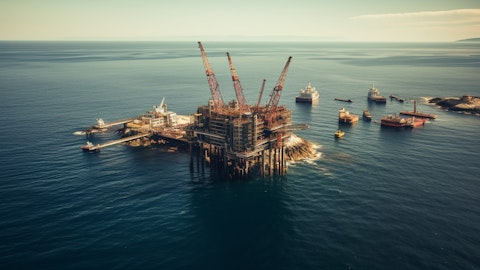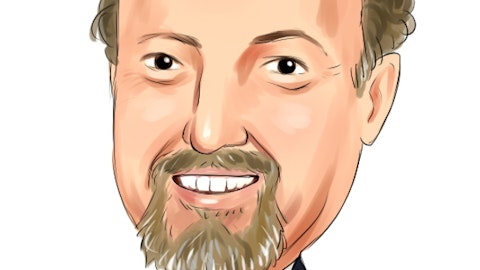Eric Carre: Yes, Jim. So to your point, if you just look at Q1, obviously you get seasonal effect. So — but more importantly, looking at the year-on-year and the general trend of the D&E margins. So first, I think it’s worth noting, as Jeff mentioned in the script, that we had our best D&E margins in 15 years. So it means that a lot of the investment we have done in the last few years are paying off. So what to watch really is the general trajectory of margins in the business. And for us, it’s a matter of balancing revenue growth, improvements in margin, improvements in returns as we continue to invest in the D&E business. So all of that to say that expect margins to continue to firm up as we get into ’24. And we’re expecting our margins to be materially higher in D&E in 2024 than they were in 2023.
Now there might be some bumps along the road from 1 quarter to the next, et cetera. It’s a business that typically tends to have a lot of moving parts. But directionally, margins will be higher in 2024 than they were in 2023.
Operator: Our next question comes from Scott Gruber with Citigroup.
Scott Gruber: So Jeff, as I step back and think about the outlook for your U.S. business, it appears that you’re on a pathway to establishing a business that will deliver more consistent and better free cash flow in the years ahead than we’ve seen historically, in part that’s given the e-frac investment investment across the portfolio. So I’m wondering if you’d just give some color kind of around that. We’re seeing the consistency now. If I heard correctly, the CapEx color doesn’t suggest a material reduction in domestic CapEx into ’24. So curious kind of around kind of bending that curve lower and just kind of overall helping this business model that’s much more consistent and less CapEx-intensive ultimately.
Jeffrey Miller: Yes. Thanks. And that is precisely what we set out to do, and that’s what’s playing out now. And so in terms of a consistent business that generates strong free cash flow through the cycle, and that’s been our intent all along. With the way we bring Zeus fleets to market, the way we invest in North America broadly, we are very deliberate about how we maximize value over the long term in North America. And I think you saw that play out in the last 2 quarters as we’ve seen the market moving around. But nevertheless, steady drumbeat of execution and cash flow delivery by Halliburton. And I expect to continue that because that is precisely our strategy. And so when it comes to cash flow, our capital allocation of our capital budget, we’re going to allocate it to those things where we see that opportunity, which we certainly see that with Zeus fleets.
But remember, that’s a demand pull, not a push strategy. So we don’t build fleets until we have contracts for fleets. And so that’s a different — completely different environment than maybe we would have seen in prior cycles from Halliburton, anything else we do in North America. Like we’ve developed some very good, in my view, fit-for-purpose drilling technology for North America. But we’re not going to overbuild it. We’re selling it into the market as the market will take it. It’s a lot of excitement about it, but our approach is still going to be consistent delivery of margins and free cash flow in North America. And so I think you’ll see us continue to do that. And that means we put e-fleets in the market, we retire sort of the fleets that are at the bottom of the stack and continue that march forward.
Scott Gruber: Got it. Okay. Appreciate the color. Unrelated follow-up here. Leverage is down to about 1x now, which is good to see. And it sounds like the cash return could step up a bit. Can you just kind of walk us through your thoughts as you move forward in time, the cycle continues, you’ll generate more free cash flow, leverage continues to come down. Outside of any M&A, should we think about that shareholder return as a percentage of free cash flow moving higher given that you will be trending somewhat on leverage on a go-forward basis?
Eric Carre: Yes, yes. I mean just starting with free cash flow, I think that you can expect 2024 free cash flow to be at least 10% over ’23. So that is going to basically help us return — increase returns on a dollar basis. Now in terms of the percentage, we’re still guided by our overall 50% return to shareholder. But directionally, it would make sense to believe that we’ll do at least what we did in 2023 in terms of the percentage return.
Operator: Our next question comes from Luke Lemoine with Piper Sandler.
Luke Lemoine: Jeff, your North America rev significantly outperformed the U.S. land rig count in ’24. And I would guess some of the factors were Zeus fleet, service quality, more stable customer base and a pickup in the Gulf of Mexico. But could you talk about any other factors that drove this? And then with the U.S. land rig count most likely down in ’24, do you think North America revs could be up in ’24 for you?
Jeffrey Miller: Yes. Look, the outperformance is just the stability of the business as I described it. And so a big part of that is 40% of our fleet by the end ’24 under long-term contracts. That creates a steady environment. So the rig count is going to move around and do what it does, but our largest part of our business, very stable. And the reality is the North America business is very big. We saw growth Gulf of Mexico and other offshore environments. However, a very large, stable North America business — land business is going to mute some of that. And as we go into ’25, I expect the same kind of performance out of our North America business sort of in spite of what rigs do. Now I do believe a repoint where DUCs are drawn down, they’re largely drawn down.





